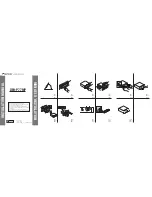
Control Unit
The control unit is the heart of the system; it is made up of one or two carriers,
and it houses the system modules. You can use either the primary carrier, or
the primary carrier and the expansion carrier if you need more lines and
extensions. Each carrier housing includes a backplane and a cover. All system
modules slide into the backplane, which channels power to the system. The
cover slides onto the front of the backplane after all the system modules have
been installed.
WARNING:
There are no customer-serviceable components inside the system
modules or backplane. There are hazardous voltages within that can
cause severe or fatal personal injury. DO NOT OPEN THE MODULES.
System Modules
The following system modules can be installed in your system:
■
■
■
■
■
Primary Processor Module provides the software intelligence that
controls the system’s features. It has jacks for a music-on-hold audio
source, a loudspeaker paging system, and a call reporting (SMDR)
device, such as a printer. It also has a green-wire grounding screw to
properly ground the primary carrier.
Expansion Processor Module extends the primary processor module’s
software capabilities to the lines and extensions located on modules in
the expansion carrier. It has a green-wire grounding screw to properly
ground the expansion carrier.
206E Module has jacks to connect a maximum of two outside telephone
lines and six extensions to the system. You can connect telephones and
other telecommunications devices (such as fax machines and modems)
to the extension jacks (either directly or through your building’s modular
wall jacks). Each 206E module has a green power indicator that shows it
is receiving power. The system requires at least one 206E module.
400E Module is similar to the 206E module, but without extension jacks.
It has four outside line jacks. This module is an inexpensive way to add
lines when you do not need more extensions.
206EC/400EC Modules provide the same capabilities as the 206E and
400E modules, but add support for Caller ID information on system
display phones. To get Caller ID, first you must subscribe to the service
from your local phone company (if it is available) on a per-line basis, then
connect those lines associated with Caller ID to the line jacks on the
206EC and/or 400EC modules. Any users with system display phones
who receive calls on Caller ID lines will get Caller ID. For more
information, see “Caller ID” in Chapter 5.
Hereafter, references to 206 modules include 206E, 206EC, and all 206 modules
used with previous releases of the product. Similarly, references to 400
modules include 400E, 400EC, and all 400 modules used with previous releases
of the product.
1-4
Overview
Содержание PARTNER II Release 4.1
Страница 6: ...iv ...
Страница 37: ...PARTNER 34D PARTNER 18D Figure 2 3 Programming Overlays for PARTNER model Phones Programming 2 15 ...
Страница 39: ...PARTNER 34D Phone PARTNER 18D 18 Phone PARTNER 6 Phone Figure 2 4 Button Locations Programming 2 17 ...
Страница 216: ...PARTNER 34D PARTNER 18D PARTNER 18 PARTNER 6 Figure 5 1 Default Line Assignments Line Assignment 301 5 119 ...
Страница 363: ...Lucent Technologies 518 455 334 Comcode 107879231 Issue 2 August 1996 ...














































